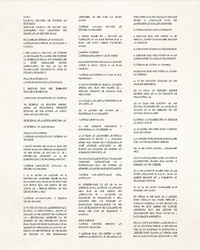Portal:Ajax/Article: Difference between revisions
No edit summary |
(Ajax article spotlight for March-April 2024) |
||
| (18 intermediate revisions by 2 users not shown) | |||
| Line 1: | Line 1: | ||
<div style="float:left;margin:0.5em 0.9em 0.4em 0;">[[File: | <div style="float:left;margin:0.5em 0.9em 0.4em 0;">[[File:Talaharan Constitution Sample.png|200px]]</div> | ||
The ''' | The '''Supreme Consensus of Talahara''' ({{wp|Central Atlas Tamazight|Takelat}}: ⵜⵉⴼⴰⵇⴰⴽⵔⴰⴷ ⵏ'ⵜⴰⵍⴰⵀⴰⵔⴰ; ''Tifaqakrad N'Talahara'') is the constitution of the [[Talahara|United Communes of Talahara]]. Drafted over a period of three years between 1838 and 1841, the first two parts of the Supreme Consensus enshrined the rights and freedoms of all persons in Talahara, in addition to democratic and property rights. Part three of the Supreme Consensus was completed later in 1841 and codified the roles of the three branches of government and divisions of power between national, regional, and communal levels of government. The Supreme Consensus has been amended a total of four times. These amendments include the addition of the third part, electoral reform, and the addition of new rights and protections. Constitutional amendments require the passage of a provision by a two-thirds supermajority in the Supreme Legislative Council (34 of 50 members) and subsequent ratification by a two-thirds supermajority by the membership of the 1,250 Communal Legislative Councils in Talahara (8,334 of 12,500 members). ('''[[Supreme Consensus of Talahara|See more...]]''') | ||
<div align="right"> | <div align="right"> | ||
'''<span class="plainlinks">[ | '''<span class="plainlinks">[[File:Ajax Article Spotlight.png|25px]] '''{{cl|Ajax Article Spotlight|See all spotlight articles}}{{*}}[[Portal talk:Ajax/Article|Suggest an Article]]</span>'''</div><noinclude> | ||
Revision as of 01:56, 7 March 2024
The Supreme Consensus of Talahara (Takelat: ⵜⵉⴼⴰⵇⴰⴽⵔⴰⴷ ⵏ'ⵜⴰⵍⴰⵀⴰⵔⴰ; Tifaqakrad N'Talahara) is the constitution of the United Communes of Talahara. Drafted over a period of three years between 1838 and 1841, the first two parts of the Supreme Consensus enshrined the rights and freedoms of all persons in Talahara, in addition to democratic and property rights. Part three of the Supreme Consensus was completed later in 1841 and codified the roles of the three branches of government and divisions of power between national, regional, and communal levels of government. The Supreme Consensus has been amended a total of four times. These amendments include the addition of the third part, electoral reform, and the addition of new rights and protections. Constitutional amendments require the passage of a provision by a two-thirds supermajority in the Supreme Legislative Council (34 of 50 members) and subsequent ratification by a two-thirds supermajority by the membership of the 1,250 Communal Legislative Councils in Talahara (8,334 of 12,500 members). (See more...)
